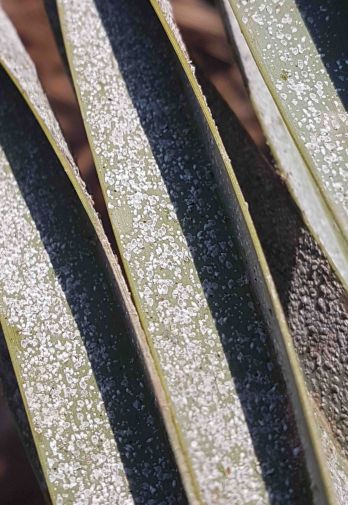Parlatoria date scale
The parlatoria date scale (Parlatoria blanchardii) is an insect that causes serious damage to a range of date palm trees.
Background
The pest is likely indigenous to Iraq and is widely distributed throughout most of the date-growing regions of the world. This includes Algeria, Argentina, Egypt, India, Iran, Israel, Libya, Mauritania, Morocco, Pakistan, Saudi Arabia, Sudan, and Tunisia.
It was introduced into the United States in 1890 with the first successful importation of date palm. Parlatoria date scale has been in central Australia since the mid-1950s.
Impacts
Parlatoria date scale mainly targets date palm (Phoenix dactylifera) from the Areceacea family. It can also affect:
- Canary Island palm (Phoenix canariensis)
- sugar date palm (Phoenix sylvestris)
- doum palm (Hyphaene thebaica)
- desert fan palm (Washingtonia filifera).
Infestations reduce the overall health and productivity of the tree. In good conditions, parlatoria date scale can spread over the surfaces of foliage and fruit of the date palm, covering them with live and dead insects. As the population increases, the insects move from these areas to the individual leaflets (pinnae).
Heavy infestations on the pinnae cause the plant to wither and die. In commercial plantings, date palms are seldom killed by parlatoria date scale, but yields are significantly decreased, and fruit may be inedible.
Management
Early identification and reporting are vital to effectively manage this pest. To avoid spreading the disease, do not:
- touch, move, or collect samples of the suspect plant material
- go to another site with any host plants after handling suspect material.
Identification
The adult female is apple-shaped and light purple in colour, underneath her exterior hard scale. Males are wingless with no compound eyes, but they have a group of simple eyes on the top of the head.
Parlatoria date scale can be seen on all parts of the date palm with heaviest infestations at the base of the leaves and crown. The primary feeding site on the host is the succulent white tissue at the base of the leafstalk.
The degree of infestation can vary and is visible in discoloration of the leaves. Sometimes it is thickest on 1 to 3 palms in a group while others do not show any symptoms. Infested palms may only affect a few fronds, usually the oldest.



